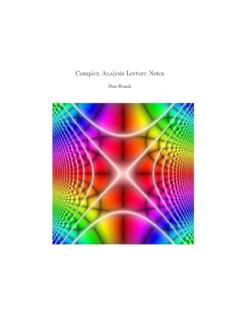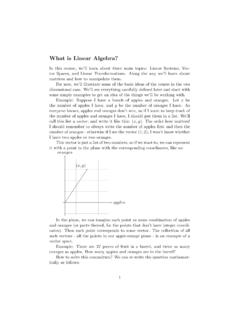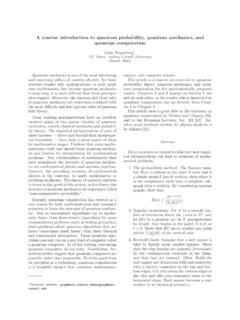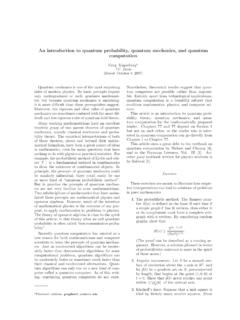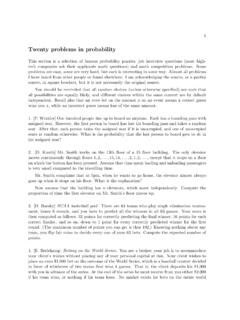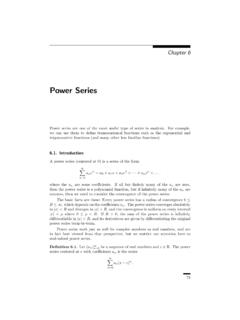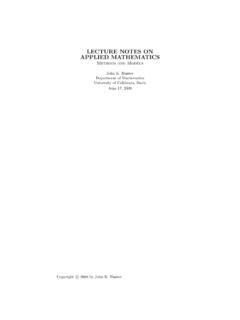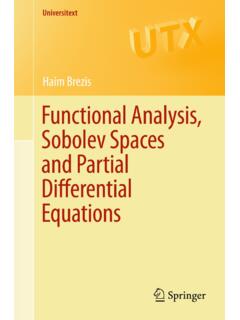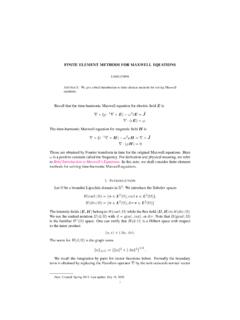Transcription of Notes on Partial Differential Equations
1 Notes on Partial Differential Equations John K. Hunter Department of Mathematics, University of California at Davis1. 1. Revised 6/18/2014. Thanks to Kris Jenssen and Jan Koch for corrections. Supported in part by NSF Grant #DMS-1312342. Abstract. These are Notes from a two-quarter class on PDEs that are heavily based on the book Partial Differential Equations by L. C. Evans, together with other sources that are mostly listed in the Bibliography. The Notes cover roughly Chapter 2 and Chapters 5 7 in Evans. There is no claim to any originality in the Notes , but I hope for some readers at least they will provide a useful supplement.
2 Contents Chapter 1. Preliminaries 1. Euclidean space 1. Spaces of continuous functions 1. Ho lder spaces 2. Lp spaces 3. Compactness 6. Averages 8. Convolutions 9. Derivatives and multi-index notation 10. Mollifiers 11. Boundaries of open sets 13. Change of variables 17. Divergence theorem 17. Gronwall's inequality 18. Chapter 2. Laplace's equation 19. Mean value theorem 20. Derivative estimates and analyticity 23. Maximum principle 26. Harnack's inequality 31. Green's identities 32. Fundamental solution 33. The Newtonian potential 34. Singular integral operators 43. Chapter 3. sobolev spaces 47. Weak derivatives 47. Examples 48.
3 Distributions 51. Properties of weak derivatives 53. sobolev spaces 58. Approximation of sobolev functions 59. sobolev embedding: p < n 59. sobolev embedding: p > n 68. Boundary values of sobolev functions 71. Compactness results 73. sobolev functions on Rn 75. Appendix 77. Functions 77. Measures 82. v vi CONTENTS. Integration 86. Chapter 4. Elliptic PDEs 91. Weak formulation of the Dirichlet problem 91. Variational formulation 93. The space H 1 ( ) 95. The Poincare inequality for H01 ( ) 98. Existence of weak solutions of the Dirichlet problem 99. General linear, second order elliptic PDEs 101. The Lax-Milgram theorem and general elliptic PDEs 103.
4 Compactness of the resolvent 105. The Fredholm alternative 106. The spectrum of a self-adjoint elliptic operator 108. Interior regularity 110. Boundary regularity 114. Some further perspectives 116. Appendix 119. Heat flow 119. Operators on Hilbert spaces 121. Difference quotients 124. Chapter 5. The Heat and Schro dinger Equations 127. The initial value problem for the heat equation 127. Generalized solutions 134. The Schro dinger equation 138. Semigroups and groups 139. A semilinear heat equation 152. The nonlinear Schro dinger equation 157. Appendix 166. The Schwartz space 166. The Fourier transform 168. The sobolev spaces H s (Rn ) 172.
5 Fractional integrals 173. Chapter 6. Parabolic Equations 177. The heat equation 177. General second-order parabolic PDEs 178. Definition of weak solutions 179. The Galerkin approximation 181. Existence of weak solutions 183. A semilinear heat equation 188. The Navier-Stokes equation 193. Appendix 196. Vector-valued functions 196. Hilbert triples 207. Chapter 7. Hyperbolic Equations 211. The wave equation 211. Definition of weak solutions 212. Existence of weak solutions 214. CONTENTS vii Continuity of weak solutions 217. Uniqueness of weak solutions 219. Chapter 8. Friedrich symmetric systems 223. A BVP for symmetric systems 223.
6 Boundary conditions 224. Uniqueness of smooth solutions 225. Existence of weak solutions 226. Weak equals strong 227. Bibliography 235. CHAPTER 1. Preliminaries In this chapter, we collect various definitions and theorems for future use. Proofs may be found in the references [4, 11, 24, 37, 42, 44]. Euclidean space n Let R be n-dimensional Euclidean space . We denote the Euclidean norm of a vector x = (x1 , x2 , .. , xn ) Rn by 1/2. |x| = x21 + x22 + + x2n and the inner product of vectors x = (x1 , x2 , .. , xn ), y = (y1 , y2 , .. , yn ) by x y = x1 y1 + x2 y2 + + xn yn . We denote Lebesgue measure on Rn by dx, and the Lebesgue measure of a set E Rn by |E|.
7 If E is a subset of Rn , we denote the complement by E c = Rn \ E, the closure by E, the interior by E and the boundary by E = E \ E . The characteristic function E : Rn R of E is defined by . 1 if x E, E (x) =. 0 if x . / E. A set E is bounded if {|x| : x E} is bounded in R. A set is connected if it is not the disjoint union of two nonempty relatively open subsets. We sometimes refer to a connected open set as a domain. We say that a (nonempty) open set is compactly contained in an open set , written , if and is compact. If , then dist ( , ) = inf {|x y| : x , y } > 0. Spaces of continuous functions Let be an open set in Rn.
8 We denote the space of continuous functions u : R by C( ); the space of functions with continuous Partial derivatives in of order less than or equal to k N by C k ( ); and the space of functions with continuous derivatives of all orders by C ( ). Functions in these spaces need not be bounded even if is bounded; for example, (1/x) C (0, 1). If is a bounded open set in Rn , we denote by C( ) the space of continuous functions u : R. This is a Banach space with respect to the maximum, or supremum, norm kuk = sup |u(x)|. x . We denote the support of a continuous function u : Rn by supp u = {x : u(x) 6= 0}. 1. 2 1. PRELIMINARIES. We denote by Cc ( ) the space of continuous functions whose support is compactly contained in , and by Cc ( ) the space of functions with continuous derivatives of all orders and compact support in.
9 We will sometimes refer to such functions as test functions. The completion of Cc (Rn ) with respect to the uniform norm is the space C0 (Rn ). of continuous functions that approach zero at infinity. (Note that in many places the notation C0 and C0 is used to denote the spaces of compactly supported functions that we denote by Cc and Cc .). If is bounded, then we say that a function u : R belongs to C k ( ). if it is continuous and its Partial derivatives of order less than or equal to k are uniformly continuous in , in which case they extend to continuous functions on . The space C k ( ) is a Banach space with respect to the norm X.
10 KukC k ( ) = sup | u|.. | | k where we use the multi-index notation for Partial derivatives explained in Sec- tion This norm is finite because the derivatives u are continuous functions on the compact set . A vector field X : Rm belongs to C k ( ) if each of its components belongs to C k ( ). Ho lder spaces The definition of continuity is not a quantitative one, because it does not say how rapidly the values u(y) of a function approach its value u(x) as y x. The modulus of continuity : [0, ] [0, ] of a general continuous function u, satisfying |u(x) u(y)| (|x y|) , may decrease arbitrarily slowly. As a result, despite their simple and natural ap- pearance, spaces of continuous functions are often not suitable for the analysis of PDEs, which is almost always based on quantitative estimates.
